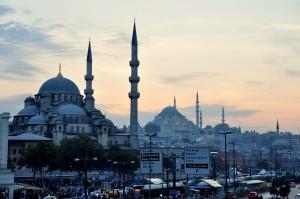
Historic Istanbul’s silhouette
Visitors to Istanbul have a general expectation of seeing an exotic place at the easternmost of Europe. This expectation is definitely appropriate but what the city offers is actually way beyond it.
It is not for nothing that Istanbul is regarded as a city founded on two continents. The city offers its visitors many examples from both European and Asian cultures, acting as a bridge between them. Sometimes you feel like you are at a mystical center in Asia or sometimes in a European city. This is an indication of a hybrid culture of Istanbul.
Istanbul was founded in 2600 BC by a Greek named Byzas and named Byzantium after its founder. It was declared as the capital of the Empire in 330 by Roman Emperor Constantine. Therefore it reached the status of Rome. When the Roman Empire was divided into two in 395, it continues to serve as the capital of Eastern Roman Empire, widely known as the Byzantine Empire.
Istanbul was known as a European city called Constantinople until 1453 when Ottomans captured it. Traces of Rome, a western civilization and Ottomans, an eastern civilization, can still be seen in the city.
The most famous places to see in the city are: Hagia Sophia, Blue Mosque, Topkapı Palace, Basilica Cistern and the Grand Bazaar. These five main pillars of Historical Istanbul are indications of the hybrid nature of the city.
In addition to these places known by everyone, there are some other special places which may be easy to be missed by visitors.
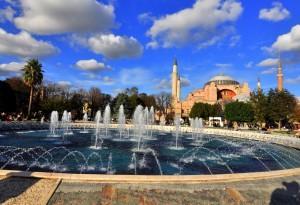
Hagia Sophia is most popular museum in Istanbul.
Süleymaniye Mosque
Due to the limited time and high number of attractions elsewhere in Istanbul, there is a place which is typically ignored: Magnificent Süleymaniye Mosque. The massive complex was built in Ottoman times for the public and it consists of madrasa, library, hospital, school, Turkish bath, kitchen and shops.
It was built in the name of Ottoman’s most famous Sultan, who is widely known as Suleiman the Magnificent, and it was built by the most famous and talented Turkish architect: Mimar Sinan. The mosque is located on the dominant hill of Historic Istanbul and is quite an eyeful, especially from Golden Horn.
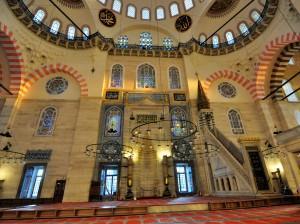
Splendid interior decoration of Süleymaniye Mosque.
Chora Church
Chora Church was previously the center of a big Byzantine monastery complex. The only surviving building from the complex is the Church dedicated to The Holy Savior Jesus.
Chora Church characterizes the golden years of late Byzantine art in a splendid way. This secret gem of Istanbul has the most impeccable iconographic depictions inherited from the Byzantine Empire.
Rustem Pasha Mosque
This secret jewel of Ottoman architecture was built by the famous architect Mimar Sinan. Built for the Grand Vizier of Sultan Suleiman the Magnificent, Rüstem Paşa, this mosque is small yet splendid.
When it comes to ceramic tiles, Blue Mosque comes to the mind initially for most people, but the most valuable Iznik ceramic tiles can be seen in Rüstem Paşa Mosque. The location of the mosque is convenient, since it is located only a few minutes walking distance from Spice Bazaar.
Kadıköy District
Kadıköy is located Asian side of Istanbul. There a few options to get to Kadıköy from European Side. The primary method is through a ferry. Crossing Bosphorus through a ferry is a very pleasant journey in Istanbul.
Once you arrive in Kadıköy, you can easily walk to Kadıköy Fish Market or Chiya Restaurant which is one of the best restaurants in Istanbul. You can also visit Tellalzade Street which is a street of antique shops and Bahariye Avenue by walking. After half a day of tour, you can walk to Moda which is a beautiful neighborhood of Kadıköy, famous for cozy cafes near seaside.
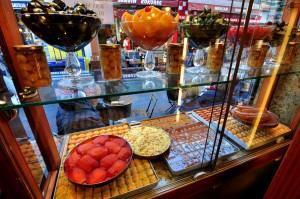
Delicious Turkish desserts in Kadıköy Market.
Istiklal Avenue
Istanbul’s New City “Beyoğlu District” was known as Paris of the East in 19th Century. This particular avenue was named as “Grande Rue de Pera”. Today it is known as Istiklal Caddesi which means Independence Avenue.
Istanbul’s most popular shopping, strolling and snacking street, Istiklal Avenue is visited by millions of people in a single day. Roughly 1.5 km long street, itis lined with boutiques, bookstores, restaurants, art galleries and cinemas.
There are a lot of attractions located on or near the street such as Çiçek Pasajı, Galatasaray Lycée, Çukurcuma (Antique Shops), Asmalı Mescit (Art Galleries), St.Antuan’s Church, Historic Pera Palace Hotel, Whirling Dervishes’ Hall (Mevlevihane) and Galata Tower.
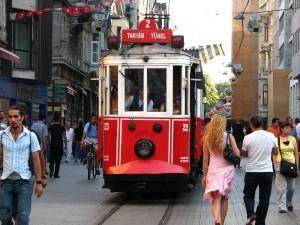
Nostalgic Tram on Istiklal Avenue.
Balat District
Balat is a district on the shore of the Golden Horn in Istanbul. Beginning with Byzantine period, there was a certain Jewish settlement there. There is a not well-known and special reason why it turned into a Jewish district during the Ottoman period. Christian Monarchs,Isabel and Ferdinand, who ended the Arab existence in Spain decided to go for the Jewish community as well.
Having had to emigrate from Spain, Jewish people were placed in Balat district by Ottoman Sultan Bayezid II. They lived in this district as a neighbor to Christians and Muslims for centuries.
Photography clubs and local agencies often organizes Balat tours and promotes these districts located on periphery now.

